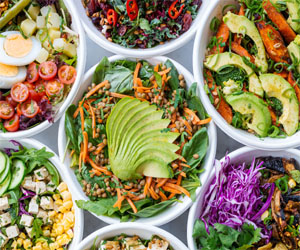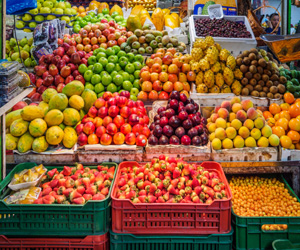


Elevate Your Culinary Game With Clever Shortcuts

Cooking is an art, but it's also a skill that demands time and effort. In our fast-paced world, cooking hacks have emerged as valuable shortcuts that allow us to create delicious dishes without sacrificing taste, quality, or nutrition. These clever tricks and tips can simplify your cooking process and make you feel like a pro in the kitchen.
The Magic Of Cooking Hacks
Cooking hacks are like secret ingredients that chefs use to make their meals taste extraordinary. They're not about compromising on flavor or quality; rather, they're about working smarter, not harder.
Here's why you should consider incorporating cooking hacks into your culinary routine:
1. Time-Saving: Cooking hacks can significantly reduce the time spent on meal preparation. In today's busy lives, this is a game-changer. You can whip up impressive dishes in a fraction of the time.
2. Money-Saving: Many cooking hacks help you make the most of ingredients, reduce waste, and save money. For example, using all parts of vegetables or repurposing leftovers can stretch your food budget.
3. Enhanced Flavor: Some hacks are like culinary secrets. They bring out flavors, intensify aromas, and add a layer of complexity to your dishes. These small tricks can elevate the taste of your meals.
4. Efficiency: Cooking hacks streamline the cooking process, making it more efficient. They allow you to multitask, so you're not chained to the stove, and they minimize the number of pots and pans you need to wash.
5. Creativity: Hacks encourage experimentation and creativity in the kitchen. They open up new possibilities and inspire you to try new techniques and flavors.
Must-Know Cooking Hacks
Here are a few essential cooking hacks that can make your time in the kitchen more efficient and enjoyable:
1. Knife Skills: Mastering basic knife skills can save time and improve your safety in the kitchen. Learn to chop, dice, and slice like a pro to speed up meal prep.
2. Use Citrus Zest: The zest of citrus fruits like lemons and oranges is a flavor powerhouse. Grate the outer skin for a burst of aroma and taste in your dishes.
3. Ice Cube Trays: Freeze herbs in olive oil or stock in ice cube trays. Pop out a cube when you need to add instant flavor to your dishes.
4. Microwave Citrus Fruits: Microwaving citrus fruits for about 10-15 seconds before squeezing can yield more juice, making it easier to extract.
5. Foil Packet Cooking: Create foil packets for baking or grilling. These packets lock in moisture and flavor, reducing the need for added fats and oils.
6. Ripen Avocados Quickly: Place avocados in a paper bag with a banana or apple to speed up the ripening process.
7. Serrated Knife For Tomatoes: Use a serrated knife to slice tomatoes. The teeth on the blade make for cleaner cuts without squashing the fruit.
8. Boil Pasta In Less Water: You don't need an abundance of water to boil pasta. Use just enough to cover the pasta, and it will cook perfectly.
9. Substitute Buttermilk: If a recipe calls for buttermilk, you can make a substitute by mixing regular milk with lemon juice or vinegar. Stir and let it sit for a few minutes.
10. Grate Cold Butter: Grating cold butter for baking makes it easier to incorporate into recipes, saving you time and effort.
The Art Of Cooking Hacks
Cooking hacks are like a treasure chest of culinary wisdom. They're the result of experienced chefs and home cooks finding innovative ways to simplify and enhance the cooking process. By integrating these hacks into your routine, you can enjoy the benefits of time-saving, cost-efficient, and flavor-boosting techniques that will elevate your culinary game. So, don your apron, grab your cutting board, and start experimenting with these clever shortcuts to take your cooking to the next level. Cooking hacks are more than just time-savers; they're your keys to culinary mastery.




A Key To Health And Enjoyment
 Preventing Dietary Deficiencies: A monotonous diet that lacks variety can lead to nutritional deficiencies. For instance, relying solely on a narrow selection of foods may result in inadequate intake of specific nutrients like vitamin C, calcium, or fiber. Over time, such deficiencies can contribute to health problems. By diversifying your diet, you reduce the risk of missing out on these critical nutrients.
Preventing Dietary Deficiencies: A monotonous diet that lacks variety can lead to nutritional deficiencies. For instance, relying solely on a narrow selection of foods may result in inadequate intake of specific nutrients like vitamin C, calcium, or fiber. Over time, such deficiencies can contribute to health problems. By diversifying your diet, you reduce the risk of missing out on these critical nutrients.
Enhancing Taste And Satisfaction: Food variety doesn't just benefit your health; it also elevates your culinary experience. A diet rich in diverse flavors and textures can make every meal a delightful adventure. Savoring different foods stimulates your taste buds and keeps meals exciting and enjoyable. It can prevent food boredom and discourage overindulgence in less nutritious, but more familiar, options.
Cultural Exploration: Exploring a variety of foods exposes you to different culinary traditions and cultural practices. This exploration can be a delicious way to learn about diverse cultures, fostering a deeper appreciation for the richness and diversity of the world. It also encourages an understanding of the importance of cultural food heritage.
Diverse Nutritional Profiles: Different foods have different nutritional profiles. For instance, leafy greens provide a wealth of vitamins and minerals, while whole grains offer fiber and sustained energy. Lean proteins like fish and poultry are rich in essential amino acids. By incorporating all of these into your diet, you ensure a holistic approach to nutrition that supports all aspects of health.
 2. Cross-Contamination
2. Cross-Contamination
Cross-contamination is a constant concern for individuals with celiac disease. Even a small amount of gluten can trigger symptoms or damage the small intestine. To mitigate this risk, create a dedicated gluten-free area in your kitchen, use separate utensils and cookware, and be cautious when dining out. Communication is key when eating at restaurants; be sure to inform the staff of your dietary restrictions to prevent cross-contamination.
3. Social And Dining Challenges
Social situations and dining out can pose challenges for those on a gluten-free diet. Friends and family may not fully understand the dietary restrictions, which can make social gatherings awkward. The key is to communicate your dietary needs clearly, offer to bring gluten-free dishes, and seek out restaurants with gluten-free options. Many establishments are now catering to the gluten-free trend, making dining out more accessible.
4. Label Reading And Hidden Gluten
Understanding food labels and identifying hidden sources of gluten is vital. Gluten can hide in unexpected places, such as sauces, dressings, and seasonings. Familiarize yourself with label reading and look for certified gluten-free products. Also, consider downloading gluten-free apps or using online resources to verify the safety of specific brands and products.
A World Of Perfection In A Tiny Cup
 For an espresso aficionado, the journey begins with selecting the finest coffee beans. They meticulously examine the origin, variety, and roast level, knowing that these factors will greatly influence the resulting shot. It's not just about caffeine; it's about the nuances and subtleties in flavor. Beans from Ethiopia offer a different experience than those from Colombia, and an espresso aficionado savors each distinctive profile.
For an espresso aficionado, the journey begins with selecting the finest coffee beans. They meticulously examine the origin, variety, and roast level, knowing that these factors will greatly influence the resulting shot. It's not just about caffeine; it's about the nuances and subtleties in flavor. Beans from Ethiopia offer a different experience than those from Colombia, and an espresso aficionado savors each distinctive profile.
Grinding the beans is a science in itself. The grind size must be just right, neither too fine nor too coarse, to achieve the perfect extraction. Precision is key, and aficionados invest in top-notch grinders that allow for minute adjustments. They know that a slight tweak can transform a mediocre shot into an exceptional one.
The espresso machine is their prized possession. It's a piece of equipment they've researched extensively, chosen carefully, and maintain lovingly. Every aspect of the machine, from the water temperature to the pressure, is controlled with meticulous care. Brewing an espresso shot is a performance, with the barista as the conductor and the machine as the orchestra.
Timing is everything. The duration of the shot, often measured in seconds, is closely monitored. Espresso aficionados understand that a few seconds too short or too long can make all the difference in flavor and aroma. It's a delicate balance, and they have it down to a precise science.
A Tapestry Of History, Diversity, And Tradition
 Cuisine And Culinary Traditions: Mediterranean cuisine is renowned worldwide for its health benefits and delicious flavors. It reflects the region's emphasis on fresh, seasonal ingredients, such as olive oil, fruits, vegetables, legumes, and grains. Dishes vary from country to country, but common ingredients and culinary techniques, such as grilling, roasting, and the use of aromatic herbs, unite the Mediterranean palate. Meals are often shared with loved ones, emphasizing the social aspect of dining.
Cuisine And Culinary Traditions: Mediterranean cuisine is renowned worldwide for its health benefits and delicious flavors. It reflects the region's emphasis on fresh, seasonal ingredients, such as olive oil, fruits, vegetables, legumes, and grains. Dishes vary from country to country, but common ingredients and culinary techniques, such as grilling, roasting, and the use of aromatic herbs, unite the Mediterranean palate. Meals are often shared with loved ones, emphasizing the social aspect of dining.
Art And Architecture: Mediterranean culture has produced some of the most stunning and enduring works of art and architecture. Greek and Roman architecture have left indelible marks on the region, and medieval influences can be seen in the cathedrals and fortresses of coastal towns. Iconic artistic traditions like mosaic work, painting, and pottery continue to flourish in Mediterranean communities.
Language Diversity: The Mediterranean region is a linguistic mosaic. Numerous languages, dialects, and scripts are spoken and written throughout the region, reflecting its rich cultural diversity. Arabic, Greek, Italian, Spanish, and Turkish are just a few of the languages spoken in Mediterranean countries.
A Taste Of Nostalgia And Culinary Delight

The appeal of classic comfort food extends beyond its sentimental value. These dishes are designed to satisfy not only our physical hunger but also our emotional cravings. Take, for example, a steaming bowl of chicken noodle soup. Its rich, savory broth and tender chunks of chicken soothe the soul and provide a sense of well-being. A slice of warm apple pie with a scoop of vanilla ice cream can transport us to a place of pure joy and indulgence. Whether it's the crispy, golden exterior of fried chicken or the creamy, cheesy layers of lasagna, classic comfort food speaks to our hearts as much as it does to our taste buds.
Classic comfort food varies from region to region and culture to culture. In the American South, it might be a plate of buttery, flaky biscuits and sausage gravy. In Italy, it could be a hearty bowl of spaghetti carbonara. In Japan, it might take the form of a comforting bowl of ramen. The diversity of classic comfort food reflects the rich tapestry of global culinary traditions, each offering its unique take on the concept of culinary solace.
Nourishing The Planet And Ourselves
 Local And Seasonal Sourcing: Embracing local and seasonal food is another pillar of food sustainability. The transportation of food over long distances generates a substantial carbon footprint. Choosing local and seasonal ingredients reduces greenhouse gas emissions and supports local economies. It also encourages consumers to connect with the natural rhythms of their environment and enjoy a wider variety of fresh, in-season produce.
Local And Seasonal Sourcing: Embracing local and seasonal food is another pillar of food sustainability. The transportation of food over long distances generates a substantial carbon footprint. Choosing local and seasonal ingredients reduces greenhouse gas emissions and supports local economies. It also encourages consumers to connect with the natural rhythms of their environment and enjoy a wider variety of fresh, in-season produce.
Reducing Food Waste: Food sustainability also involves reducing food waste, a significant problem worldwide. By minimizing waste at all stages of the food supply chain, from production to distribution and consumption, we can alleviate the strain on resources and landfills. This requires better planning, innovative packaging, and a shift in consumer behavior.
Healthy Eating: Healthy eating is an integral component of food sustainability. A diet based on nutrient-dense, minimally processed foods contributes to overall well-being and longevity.
Nourishing Your Body One Sip At A Time
 Antioxidant Benefits
Antioxidant Benefits
Antioxidants are nature's superheroes when it comes to fighting off free radicals and preventing cellular damage. Nutrient-packed beverages frequently contain an abundance of antioxidants sourced from fruits, vegetables, and other plant-based ingredients. These antioxidants help protect our bodies from oxidative stress and reduce the risk of chronic diseases.
Weight Management And Digestive Health
Nutrient-packed beverages can be a valuable tool for those looking to manage their weight. A well-balanced smoothie or juice can provide satiety while keeping calories in check. Additionally, they often include dietary fiber, which supports healthy digestion and promotes a feeling of fullness.
Customization And Variety
One of the beauties of nutrient-packed beverages is their versatility. You can customize them to suit your taste and nutritional needs.